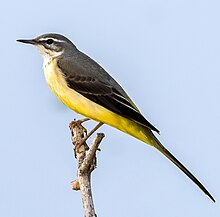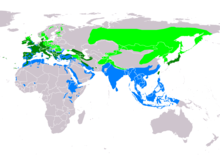灰鹡鸰
印度 海德拉巴 的灰鹡鸰
鸟鸣
科学分类
界:
动物界 Animalia
门:
脊索动物门 Chordata
纲:
鸟纲 Aves
目:
雀形目 Passeriformes
科:
鹡鸰科 Motacillidae
属:
鹡鸰属 Motacilla
种:
灰鹡鸰 M. cinerea
二名法
Motacilla cinerea
灰鹡鸰的分布范围 繁殖季
留鸟
非繁殖季
異名
Motacilla melanope Calobates melanope
灰鶺鴒 (學名 :Motacilla cinerea 鶺鴒科 鶺鴒屬 下的一种鳥類。[ 2] [ 3]
全長約18-19公分。該物種看起來與黃鶺鴒 有些相似,但其下腹部的黃色僅限於喉部和泄殖腔 。繁殖期的雄鳥有黑色喉部,而雌鳥則有更多白色區域。其性別及冬夏間的羽色略有不同。[ 4]
該物種分布廣泛,幾個種群在古北界 的歐亞大陸 繁殖,並遷徙至亞洲和非洲的熱帶地區。繁殖時,牠們一般與流水相關,雖然牠們可能會利用溪流附近的人造建築來築巢。非繁殖季節時,牠們也可見於湖泊、海岸及其他水域棲地。相對於黃鶺鴒 ,這種鳥類更偏好山區活動。[ 5] [ 3]
指名亞種 (比利時 ) 卵,威斯巴登博物館
灰鶺鴒的二名法 Motacilla cinerea 由馬馬杜克·唐斯塔爾 於1771年在其著作《英國鳥類學》Ornithologia Britannica 中首次介紹。[ 6] [ 7] Motacilla 是拉丁語 中對灰鶺鴒的名稱;儘管實際上是motare 的指小詞,意思是「移動」,但在中世紀時代引發了對cilla 為「尾巴」的誤解。種小名cinerea 來自拉丁語cinis ,意為「灰燼」,指「灰色」。[ 8]
該物種的親緣關係尚未完全解決;它屬於非洲 鶺鴒之外的分支 ,這些物種在外部形態 上令人困惑,mtDNA 細胞色素b 與NADH脫氫酶 亞基 2的序列 數據無法穩健地解決其親緣關係。雖然現有物種可能與黃頭鶺鴒 和一些西方黃鶺鴒 最為接近,但其確切的關係仍不明確。[ 9]
已確認的三個亞種 包括:[ 10]
M. c. patriciae (沃里 ,1957) – 亞速爾群島M. c. schmitzi (楚西 ,1900) – 馬德拉群島M. c. cinerea (唐斯塔爾 ,1771) – 西歐、加那利群島與西北非洲至中部、東部和東北亞
Male M. c. melanope 灰鶺鴒 日本 這種纖細的鶺鴒有狹窄的白色眉紋和斷裂的眼環。上半身為灰色,與白色下腹部形成對比的黃色泄殖腔使其具有辨識度。繁殖期雄鳥有黑色喉部,邊緣有白色的鬍鬚狀條紋。牠們通常單獨或成對在草地或淺水沼澤地覓食,也會使用水中的岩石,並經常棲息在樹上。牠們的叫聲清脆尖銳,歌聲由顫音組成。[ 11]
灰鶺鴒廣泛分布於古北界地區,具有數個明顯的種群。指名型(包括caspica ,分布於伊朗、土耳其和高加索地區)來自西歐,包括不列顛群島、斯堪地那維亞和地中海地區。melanope 亞種主要分布在東歐和中亞,主要沿著烏拉爾山脈、天山山脈和喜馬拉雅山脈繁殖,與指名亞種之間的區分並不明顯。[ 12] robusta 亞種在亞洲東北部的西伯利亞繁殖,分布範圍延伸至韓國和日本,這些亞種在東南亞過冬。島嶼型包括亞速爾群島的patriciae 、馬德拉群島 的schmitzi 及加那利群島的canariensis 。
牠們有時會出現在阿拉斯加西部的島嶼上,但已知有時作為迷鳥出現在更南的加利福尼亞。[ 13]
指名亞種(比利時) 繁殖季節從四月到七月,巢築在快速流動的溪流或河流旁的堤岸上,位於石頭和樹根之間。[ 11] [ 14] [ 15] [ 16] [ 17] [ 18] [ 19]
在其分布區的一些地區,白喉河烏 與灰鶺鴒共享相同的棲地,並且有一些異種哺育 的紀錄,即成鳥灰鶺鴒為河烏的雛鳥餵食。[ 20]
這些鳥類捕食各種水生無脊椎動物,包括成蟲蒼蠅、蜉蝣、甲蟲、甲殼類和軟體動物。[ 21] chi-cheep 叫聲,飛向路邊更遠的地方,但飛行一段距離後又會折返至原地。[ 14]
在冬季,牠們會成小群過夜。[ 22] [ 14] [ 23]
成鳥經常受到寄生蟲蜱 Ixodes ricinus Borrelia [ 24] Isospora [ 25] 大杜鵑 有時會對該物種進行巢寄生 ,[ 26] 紅隼 有時會捕食牠們。[ 27]
^ BirdLife International. Motacilla cinerea The IUCN Red List of Threatened Species 2017 : e.T22718392A111215843. [2024-05-27 ] . doi:10.2305/IUCN.UK.2016-3.RLTS.T22718392A111215843.en ^ International Ornithologists' Union . Gill, Frank ; Donsker, David; Rasmussen, Pamela , 编. IOC World Bird List 14.1 . [2023-12-20 ] (英语) . ^ 3.0 3.1 灰鶺鴒 . 陽明山國家公園全球資訊網-中文網. [2024-05-27 ] . (原始内容存档 于2024-05-27) (中文(臺灣)) . ^ 劉小如; 丁宗蘇; 方偉宏; 林文宏; 蔡牧起; 顏重威. 台灣鳥類誌第二版(下) . 台灣: 行政院農業委員會林務局. 2012-12-01: 526—528 [2023-08-18 ] . ISBN 9789860339277存档 于2020-05-20) (中文(臺灣)) . ^ 灰鶺鴒 . 衛生福利部國家中醫藥研究所. [2024-05-27 ] . (原始内容存档 于2024-05-27). ^ Schodde, R.; Bock, W.J. The valid name for the Grey Wagtail . Bulletin of the British Ornithologists' Club. 2008, 128 (2): 132–133. ^ Tunstall, Marmaduke . Newton, Alfred , 编. Tunstall's Ornithologia britannica . London: J. Akerman. 1880: 2 [1771] (拉丁语) . ^ Jobling, James A. The Helm Dictionary of Scientific Bird Names . London, United Kingdom: Christopher Helm. 2010: 107 , 261. ISBN 978-1-4081-2501-4 ^ Voelker, Gary. Systematics and historical biogeography of wagtails: Dispersal versus vicariance revisited. Condor. 2002, 104 (4): 725–739. S2CID 85844839 doi:10.1650/0010-5422(2002)104[0725:SAHBOW]2.0.CO;2 ^ Gill, Frank ; Donsker, David; Rasmussen, Pamela (编). Waxbills, parrotfinches, munias, whydahs, Olive Warbler, accentors, pipits . IOC World Bird List Version 11.1. International Ornithologists' Union. January 2021 [3 June 2021] . ^ 11.0 11.1 Rasmussen PC; Anderton, JC. Birds of South Asia: The Ripley Guide. Volume 2. Smithsonian Institution & Lynx Edicions. 2005: 317. ^ Hume, AO. The nests and eggs of Indian Birds. Volume 2. . R H Porter, London. 1890: 207. ^ Checklist of Alaska birds (PDF) 15th. University of Alaska, Fairbanks. 2009 [30 October 2009] . ^ 14.0 14.1 14.2 Ali, S; Ripley, S D. Handbook of the birds of India and Pakistan. Volume 9 2nd. 1998: 290–292. ^ Klemp S. Effects of parental effort on second brood, moult and survival in the Grey Wagtail Motacilla cinerea. Ardea. 2000, 88 (1): 91–98. ^ Smiddy, P.; O'Halloran, J. Breeding biology of the Grey Wagtail Motacilla cinerea in southwest Ireland. Bird Study. 1998, 45 (3): 331–336. doi:10.1080/00063659809461104 ^ Rodríguez B.; Rodríguez A. Breeding biology of Grey Wagtail Motacilla cinerea canariensis on Tenerife, Canary Islands (PDF) . Acta Ornithol. 2007, 42 (2): 195–199 [2009-10-28 ] . doi:10.3161/068.042.0203 原始内容 (PDF) 存档于2016-03-04). ^ Robinson, R.A. BirdFacts: profiles of birds occurring in Britain & Ireland . BTO Research. 2005 [28 October 2009] . ^ Jørgensen OH. Migration and Aspects of Population Dynamics in the Grey Wagtail Motacilla cinerea. Ornis Scandinavica. 1976, 7 (1): 13–20. JSTOR 3676170 doi:10.2307/3676170 ^ Yoerg, SI; O'Halloran, J. Dipper Nestlings Fed by a Gray Wagtail (PDF) . Auk. 1991, 108 (2): 427–429. ^ Santamarina, Jesus. The Grey Wagtall (Motacilla cinerea) diet in the Ulla river basin, Galicia. NW Spain (PDF) . Ardeola. 1989, 37 (1): 97–101 (西班牙语) . ^ Neelakantan, KK. Roosting of the Grey Wagtail [Motacilla caspica (Gmelin)] in the Thekkady Wild Life Sanctuary . J. Bombay Nat. Hist. Soc. 1964, 61 (3): 691–692. ^ Nickell, Walter P. Return of Northern Migrants to Tropical Winter Quarters and Banded Birds Recovered in the United States. Bird-Banding. 1968, 39 (2): 107–116. JSTOR 4511469 doi:10.2307/4511469 ^ Dubska, Lenka; Ivan Literak; Elena Kocianova; Veronika Taragelova; Oldrich Sychra. Differential Role of Passerine Birds in Distribution of Borrelia Spirochetes, Based on Data from Ticks Collected from Birds during the Postbreeding Migration Period in Central Europe . Applied and Environmental Microbiology. 2009, 75 (3): 596–602. Bibcode:2009ApEnM..75..596D PMC 2632145 PMID 19060160 doi:10.1128/AEM.01674-08 ^ Svobodova, M. Isospora, Caryospora and Eimeria (Apicomplexa: Passeriform Birds from Czech Republic (PDF) . Acta Protozoologica. 1994, 33 : 101–108. ^ Adamík P.; Hušek J.; Cepák J. Rapid decline of Common Cuckoo Cuculus canorus parasitism in Red-backed Shrikes Lanius collurio (PDF) . Ardea. 2009, 97 (1): 17–22 [2013-03-29 ] . S2CID 86228074 doi:10.5253/078.097.0103 原始内容 (PDF) 存档于2016-03-04). ^ Costantini, David; Casagrande, Stefania; Di Lieto, Giuseppe; Fanfani, Alberto; Dell'Omo, Giacomo. Consistent differences in feeding habits between neighbouring breeding kestrels (PDF) . Behaviour. 2005, 142 (9–10): 1403–1415. doi:10.1163/156853905774539409 原始内容 (PDF) 存档于2007-07-10).






